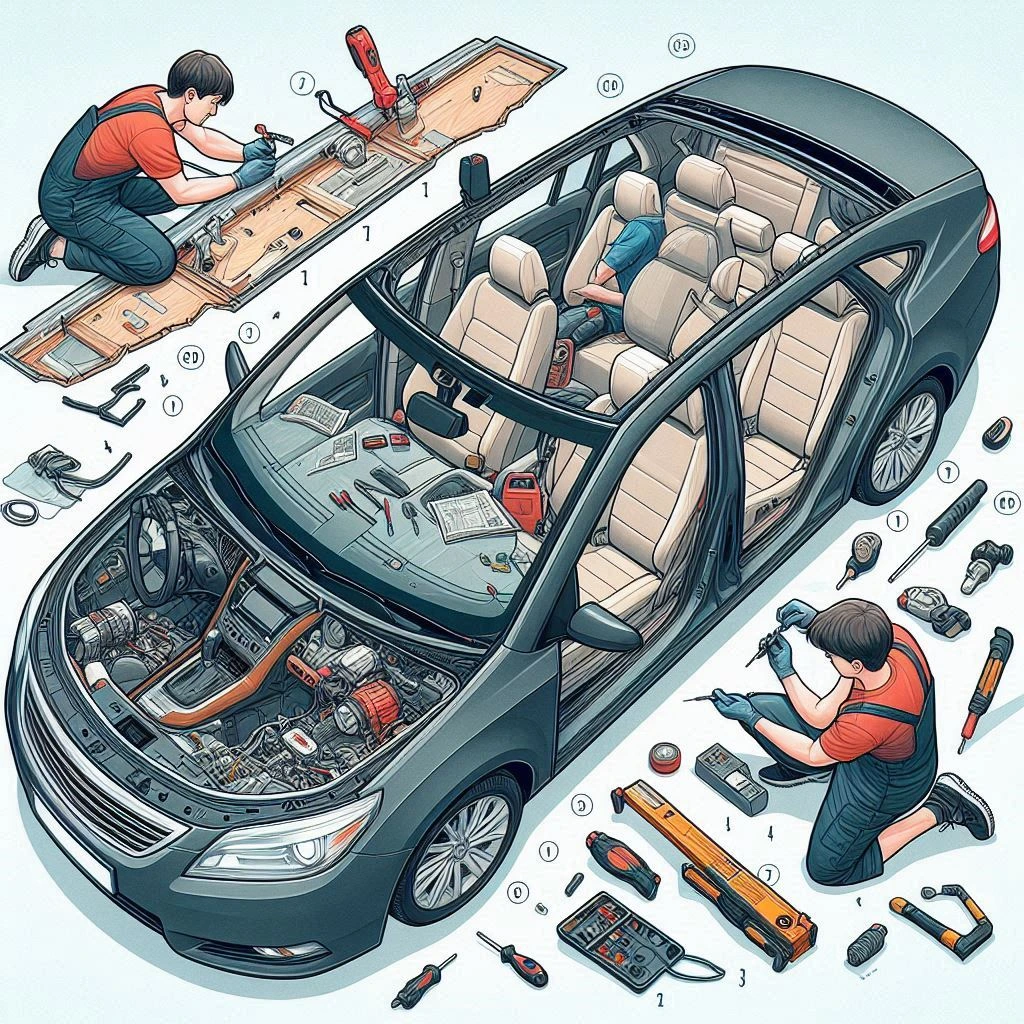
Step-by-Step Car Interior Roof Replacement Tutorial. If you’re looking to give your car’s interior a fresh, new look without spending a fortune at the repair shop, a DIY car interior roof replacement can be a highly rewarding project. This detailed guide will walk you through each step of the process in a friendly, approachable manner so you can confidently transform your vehicle’s headliner.
Car Interior Roof Replacement: Getting Started
Before diving into the project, it’s important to set clear expectations and prepare yourself mentally and physically for the work ahead. A car interior roof replacement involves careful removal of the old headliner, cleaning and preparing the surface, and then applying the new material. Begin by ensuring that you have a clear plan of action, all the necessary tools, and a comfortable workspace where you can work without rush. Remember that patience and attention to detail are your best friends on this project.
Take some time to familiarize yourself with your car’s interior layout. Look for any clips, fasteners, or adhesives that hold the original roof lining in place. This initial review will help you determine the best approach for removal and replacement. It’s also a good idea to check online forums or video tutorials related to your specific car model, as these resources can offer valuable insights into any model-specific challenges you might encounter.
Car Interior Roof Replacement: Tools and Materials
A successful car interior roof replacement starts with gathering the right tools and materials. Here’s a checklist to help ensure you’re fully equipped for the job:
- New Headliner Material: Purchase a replacement headliner fabric or vinyl that matches your style.
- Adhesives: Choose a high-quality automotive adhesive suitable for your new material. Spray adhesives often work well for a smooth, even application.
- Utility Knife or Scissors: For trimming and shaping the replacement material accurately.
- Measuring Tape and Chalk/Marker: To mark precise measurements on both the car roof and the new material. (Read More: Top Car Interior Shampooer for a Spotless Clean).
- Plastic Scraper or Putty Knife: To help remove the old adhesive without damaging the underlying structure.
- Cleaning Supplies: Such as a mild cleaner, microfiber cloths, and possibly a vacuum to remove dust and debris.
- Protective Gear: Gloves, safety glasses, and a dust mask to keep yourself safe throughout the project.
Ensuring that you have every tool on this list before starting will save you time and help avoid any mid-project interruptions. Taking a little extra time to plan now can lead to a much smoother car interior roof replacement experience.
Car Interior Roof Replacement: Preparing Your Workspace
Setting up a dedicated, well-lit, and ventilated workspace is key to a successful headliner replacement. Ideally, choose a space where you can spread out your tools and work comfortably without worrying about dust or weather conditions. Lay down protective coverings on the floor and seats to guard against adhesive spills and accidental cuts. (Read More: Enhancing Car Interiors: The Appeal of Lucite Car Lamps in Modern Design).
Open windows or work in a well-ventilated area if you’re using spray adhesives or strong solvents. Ensure that the workspace is organized so that your tools and materials are within easy reach. This preparation not only makes the process more efficient but also helps maintain a safe environment while you work on your car interior roof replacement.
Car Interior Roof Replacement: Removing the Old Interior Roof
The next step in the process involves carefully removing the old headliner. Begin by gently prying away any trim pieces, handles, or light fixtures that may be attached to the roof. Keep track of any fasteners or clips that you remove—they’ll likely be needed during reinstallation.
Once the trim is removed, start detaching the headliner fabric from the underlying board or foam. Use your plastic scraper or putty knife to lift the edges of the fabric. In many cases, the old adhesive will release with a bit of gentle pressure, but take care not to tear the material if you plan to use it as a reference for the new installation. If the old material is stubborn, apply a bit of heat using a hairdryer on a low setting to soften the adhesive before prying it off. (Read More: Car Auctions vs. Dealerships: Where to Find the Best Deals in 2024).
As you remove the old fabric, inspect the board for any damage or irregularities. Address any dents or structural issues now, as they might affect the new installation. The goal is to have a smooth, even surface for your new material.
Car Interior Roof Replacement: Cleaning and Surface Preparation
:max_bytes(150000):strip_icc()/hand-wash-of-car-headlamp--hands-in-disposable-gloves-scrub-the-headliner-922051288-5c89bb7346e0fb0001cbf61d.jpg)
After removing the old headliner, thorough cleaning of the surface is essential for a long-lasting car interior roof replacement. Start by vacuuming any loose debris and dust from the board. Then, use a mild automotive cleaner to wipe down the entire area. Removing any residual adhesive is critical because leftover residue can interfere with the new glue’s bond.
If you find stubborn adhesive, gently scrape it off using your plastic scraper, being careful not to damage the board. For extra stubborn spots, a solvent recommended by your adhesive’s manufacturer may be necessary. Allow the cleaned surface to dry completely before proceeding to the next step. A well-prepared surface ensures that your new material will adhere properly and look flawless.
Car Interior Roof Replacement: Measuring and Cutting the Replacement Material
Now comes the exciting part—measuring and cutting your new headliner material. Using a measuring tape, carefully measure the dimensions of your car’s interior roof. Transfer these measurements onto the new material using a chalk or fabric marker. Accuracy at this stage is essential; taking precise measurements will help ensure that the replacement fits perfectly.
Once marked, use a utility knife or a pair of sharp scissors to cut out the new material. Work slowly and deliberately to follow the markings exactly. If your new headliner includes any design patterns or textures, take extra care to align them with the contours of your car’s interior. A good tip is to cut the material slightly larger than needed and trim down gradually, ensuring a perfect fit without the pressure of making a single perfect cut on the first try.
Car Interior Roof Replacement: Installing the New Roof Lining
With your new material cut to size, it’s time to install it. Start by applying your chosen adhesive to the cleaned board. Whether you’re using a spray adhesive or a brush-on variant, make sure to follow the manufacturer’s instructions for the best results. Some adhesives require a short waiting period after application to become tacky; be sure to adhere to these guidelines to ensure proper bonding.
Carefully position the new headliner material on the board. Start at one end and work your way across, smoothing the material as you go to prevent bubbles and wrinkles. Use your hands (protected with gloves) or a clean, soft cloth to press the material firmly into place. If any air bubbles or imperfections appear, gently lift the material and reapply it with a little more adhesive if necessary.
Pay close attention to the edges where the material meets the trim. A steady, methodical approach will help you achieve a professional-looking finish. This step is all about precision and patience—take your time to align the fabric perfectly along the contours of your car’s interior.
Car Interior Roof Replacement: Finishing Touches and Checks

Once the new headliner is in place, give your car interior roof replacement a careful once-over. Look for any areas where the material may have lifted or where adhesive might be visible. Smooth these areas gently with your hands or a soft tool designed for the purpose. If you find any gaps or loose edges, apply a small amount of additional adhesive to secure the material firmly.
At this stage, reattach any trim pieces, light fixtures, or handles that were removed earlier. Make sure that every component is properly secured and that the new headliner aligns well with the car’s interior design. Take your time to inspect the entire installation from different angles, ensuring that the finish looks seamless and professional.
Even though this process can be detailed and sometimes challenging, the satisfaction that comes from a job well done is immense. Throughout the process, remind yourself that every careful step contributes to the overall quality of your car interior roof replacement.
Car Interior Roof Replacement: Post-Installation Care
After completing the installation, maintaining your new headliner will help preserve its fresh appearance for years to come. Avoid exposing the car interior to harsh chemicals or extreme temperatures, especially during the initial curing period for the adhesive. Regularly dust and gently clean the surface with a soft, damp cloth to prevent dirt accumulation and to keep the material looking vibrant.
If you notice any minor issues, such as slight lifting of the material in certain areas, address them promptly. Keeping a small amount of the original adhesive on hand can be useful for quick touch-ups. By taking these simple care measures, you ensure that your car interior roof replacement continues to enhance the comfort and style of your vehicle.
Car Interior Roof Replacement: Tips for a Smooth Process

Here are a few friendly tips to help make your project as enjoyable and stress-free as possible:
- Take Your Time: Rushing through any step can lead to mistakes. Enjoy the process, and don’t hesitate to pause if you need to reassess any part of the installation.
- Work with a Friend: Having someone assist you can be incredibly helpful, whether it’s holding the material in place or offering a second opinion on alignment.
- Practice on a Small Section: If this is your first time attempting a headliner replacement, consider practicing on a small section of the roof to get a feel for the adhesive and material before tackling the entire surface.
- Stay Organized: Keep your tools and materials neatly arranged. This not only improves efficiency but also minimizes frustration during the project.
- Keep Safety in Mind: Always wear protective gear, and work in a well-ventilated area to avoid inhaling any fumes from adhesives or cleaning agents.
Every DIY project has its learning curve, and your car interior roof replacement is no exception. Embracing the process with a positive attitude will make each step more manageable and even enjoyable.
By following these detailed, step-by-step instructions, you’re well on your way to transforming your car’s interior with a brand-new headliner. Each phase of the project—from planning and preparation to installation and final touch-ups—plays a crucial role in ensuring that your car interior roof replacement is executed flawlessly. Enjoy the journey of working on your car, and take pride in the personalized upgrade that reflects your unique style and attention to detail.




